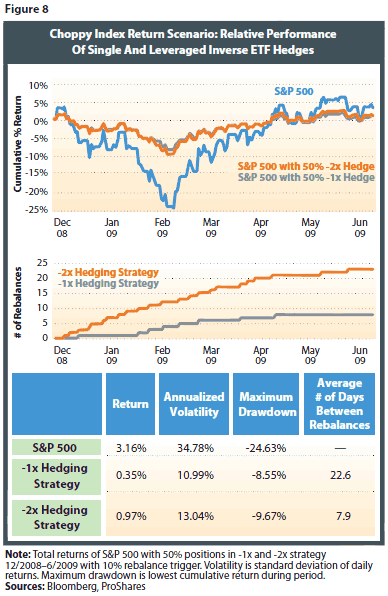Hedge Volatility in Your Portfolio with These Alternative ETFs ETF News And Commentary
Post on: 25 Май, 2015 No Comment

It surely is hard to predict market behavior. At the start of December, the major indices of the U.S. stock market were sitting at all-time highs, with speculations of an early Santa Claus rally doing rounds. But the trend saw an abrupt change and both Dow and the S&P 500 lost over 5% from their all-time high reached on December 5 before the Fed’s dovish comments yesterday.
Notably, the U.S. stocks enjoyed their strongest one-day gains in more than a year in yesterday’s trading session, making up for more than 40% of the losses incurred this month. The Fed modified its ‘considerable time’ language to ‘patient’ about the timing of the first interest rate hike since 2006. This means that the Fed is on track to raise interest rates given a strengthening U.S. economy but not in a hurry and will keep patience in doing so.
The accelerating U.S. job market, stepped-up economic activities, better-than-expected GDP numbers, improving business conditions, renewed optimism in housing recovery and rising consumer confidence will likely support the rally in the U.S. stock market. This is because low gasoline prices are actually driving consumer spending, which accounts for more than two-thirds of the U.S. economic growth (read: Complete Your Holiday Shopping with These 3 Consumer ETFs ).
The major culprit of the stock market decline is the relentless slide in oil prices that raised fears of a global economic slowdown and deflation that is unlikely to rebound anytime, thereby bringing volatility back into the market. Additionally, weak international fundamentals such as recession in Japan, a struggling Eurozone, disappointing data from China, the ongoing turmoil in Russia, and slowdown in other emerging nations are adding to the woes.
Notably, the fear gauge — CBOE Volatility Index (VIX) — climbed nearly 46% this month, suggesting high fear levels in the future. The rise in market volatility is further confirmed by the latest Zacks Earnings Trend report, which showed that the earnings estimates for the current quarter are coming down and the pace of negative revisions has accelerated in recent days. Q4 earnings for companies in the S&P 500 are now expected to be up 3.3% year over year versus 9.6% growth projected in early October (read: Volatility ETFs in Focus on Oil Upheaval ).
With volatility on the rise, many investors are looking for ways to exploit the current trend while protecting their long equity positions. For those investors, we have highlighted some volatility hedged ETFs that could prove beneficial amid market turbulence. Investors should note that these funds have the potential to stand out and might outperform the simple vanilla funds in case of rising volatility.
PowerShares S&P 500 Downside Hedged Portfolio ( PHDG )
This actively managed fund seeks to deliver positive returns in rising or falling markets that are uncorrelated to broad equity or fixed-income market returns. It tries to follow the S&P 500 Dynamic VEQTOR Index, which provides broad equity market exposure with an implied volatility hedge by dynamically allocating between different asset classes: equity, volatility and cash. The S&P 500 Total Return represents the equity component while the S&P 500 VIX Short-Term Futures Index represents the volatility component of the index.
The non-equity (volatility + cash) portion makes up for 23% of PHDG while the rest goes to equity. In terms of equity holdings, the fund is widely diversified across sectors and securities. None of the firms holds more than 3.64% share while technology, health care, financials, consumer discretionary and industrials occupy the top five spots with a nice mix in the portfolio (see: all large cap ETFs here ).
The fund has accumulated $638.5 million in its asset base so far and trades in a moderate volume of more than 138,000 shares per day. It charges 40 bps in fees per year from investors and is down 3.5% from the record high of $35.21 reached on December 5.
This is an ETN option tracking the S&P 500 Dynamic VEQTOR Index. VQT uses volatility futures contracts directly to hedge volatility. It increases allocation to the equity component as measured by the S&P 500 Total return index, in times of low volatility. On the other hand, it increases volatility exposure as measured by the S&P 500 VIX Futures Total Return index and allocates entirely into cash if the index slumps 2% or more in the preceding 5 days. In this manner, the note manages to keep a check on volatility.
The product has amassed $659.6 million in AUM while sees light volume of nearly 20,000 shares per day on average. It is a bit pricey charging 95 bps in annual fees. The ETN has lost 3.5% from the record high of $158.87 reached on December 5.
ETRACS S&P 500 VEQTOR Switch ETN ( VQTS )

This product, launched early this month, seems to have entered the market at the right time when volatility levels spiked. It has seen strong investor interest as it has pulled in $23.9 million in AUM within two weeks. The ETN follows the S&P 500 VEQTOR Switch Index (read: Play Market Volatility with This New UBS ETF (VQTS) ).
The index seeks to simulate a dynamic portfolio that allocates between equity and volatility based on realized volatility in the broad equity market. The allocation to the equity component is dynamically adjusted to gain exposure to the S&P 500 with a target volatility of 10%. The remainder of the index is allocated to the S&P 500 VIX Futures Long/Short Switch Index that allocates between cash and long or short positions in an index of VIX futures with a constant one-month maturity.
This means that when realized volatility is 10% or less, the index allocates 100% to the S&P 500 Index. When realized volatility exceeds 10%, the index allocates a portion to the S&P 500 Index and the remainder to the futures Index. This approach results in higher expense ratio of 0.95%. Volume is also paltry at about 5,000 shares. VQTS is down nearly 5% since December 5.
Bottom Line
Investors could definitely hedge volatility in their portfolio with the help of the above-mentioned products, which provide dynamic exposure according to the level of market volatility. These alternative ETFs could prove great choices when it comes to protection against market downturn.
Want the latest recommendations from Zacks Investment Research? Today, you can download 7 Best Stocks for the Next 30 Days. Click to get this free report >>
Want the latest recommendations from Zacks Investment Research? Today, you can download 7 Best Stocks for the Next 30 Days. Click to get this free report














